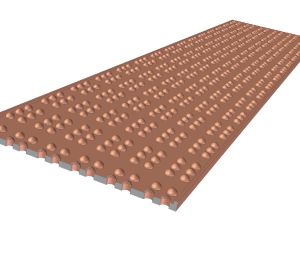Scientists of the KIT Institute of Microstructure Technology (IMT) are presently developing a new computer display in Braille. The research group headed by Dr. Bastian Rapp is designing an inexpensive device based on microfluidics, i.e. the behavior of liquids in smallest space. The highly innovative project of young scientists is funded by the Federal Ministry of Education and Research (BMBF).
The joint project idea of the IMT working group and the Studies Center for Visually Impaired Students (SZS) at KIT was recently honored at the BMBF workshop “Mensch-Technik-Kooperation - Systeme für den Menschen“ (Man-Technology-Cooperation – Systems for Man) in Darmstadt. So far, visually impaired and blind persons have been able to read computer texts with the help of an output device called Braille reader. When it is connected to the PC, it converts letters into palpable Braille characters. A Braille reader usually represents 40 and at the maximum 80 characters of screen text in Braille. Small pins are moved upwards or downwards in an electronically manner. “Braille readers require very high production costs and, hence, are expensive,” says Bastian Rapp. His research group is now developing a device that represents 960 characters at the same time and can be produced at low costs due to the use of inexpensive components. Instead of the pins, the user feels spot-shaped bulges of a plastic surface that is deformed by passing water through smallest channels. With the help of paraffin, microvalves open and close membranes in order to control the liquid flow. “With this fast-response technology on smallest space, we can address a number of segments. The display has about the size of a DIN A4 sheet,” says Rapp. Since 2009, he has been heading the Junior Research Group on “Indirect Microfluidic Systems” financed from funds of the Excellence Initiative. The 31-year-old researcher emphasizes that the development of the microfluidic Braille display profits strongly from the know-how of the project partner SZS and the early integration of future users. Funding of the project by the BMBF for a duration of two years as a trend-setting and application-friendly idea for the design of the interaction of man and technology will start in spring 2012.
Being “The Research University in the Helmholtz Association”, KIT creates and imparts knowledge for the society and the environment. It is the objective to make significant contributions to the global challenges in the fields of energy, mobility, and information. For this, about 10,000 employees cooperate in a broad range of disciplines in natural sciences, engineering sciences, economics, and the humanities and social sciences. KIT prepares its 22,800 students for responsible tasks in society, industry, and science by offering research-based study programs. Innovation efforts at KIT build a bridge between important scientific findings and their application for the benefit of society, economic prosperity, and the preservation of our natural basis of life. KIT is one of the German universities of excellence.

